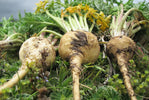
Maca Herb
, 3 min reading time

, 3 min reading time
Maca, Lepidium meyenii, is a tuberous root that grows in the high elevations of the Andes mountain range. Maca is known as an adaptogen, broadly contributing to overall wellbeing and a healthy mood. According to folk belief Maca is an aphrodisiac, enhancing sexual drive in humans and domestic animals which tends to be reduced at higher altitudes. Maca is in the Brassicaceae family, and shares many of the beneficial constituents of other members in this plant family such as broccoli, kale, cabbage, rutabagas, turnips, radishes, and many more. Maca grows both wild and in cultivation in a naturally occurring variety of colors. Variation of color relates to the periderm or the outer covering, however the majority of biomass found in the core and main mass of all Maca looks the same. Traditionally, all colors of Maca were harvested and used together by the Andean people. In 2008, the Peruvian government decided to clarify the confusion between the two scientific names that were used for Maca, Lepidium meyenii and Lepidium peruvianum. It was decided that L. peruvianum would be used to describe the cultivated type of maca grown in Peru only, and L. meyenii would be used to describe a more wild type of Maca. Cultivation does not change the lineage of genetics, which taxonomy is based off of. Therefore, L. peruvianum is not currently considered an accepted scientific name for Maca, nor is it considered a synonym of L. meyenii.
What is Maca Used For?
In 1653 Father Bernabe Cobo, a chronicler with the Spanish conquest, described Maca as growing in the harshest, coldest regions where no other plant for man's sustenance could be grown. Maca was utilized as a medicinal food by the people of the high altitude Andes regions of Peru and Bolivia and was an important staple of their diet as it is able to grow wild and survive the harsh climates. Maca supported the people to adapt, reproduce, and thrive in harsh conditions that include extreme cold, rugged terrain, low oxygen, intense sunlight and strong winds. Maca was often dried after harvesting to allow for long term storage, and rehydrated as needed. Traditional drying methods that involve outdoor drying in the high elevations of the Andes over about 8 weeks, expose the roots to extreme temperature variations that damage the tissues as water is gradually lost. This tissue damage leads to the release of hydrolytic enzymes which generate bioactive compounds such as macamides and isothiocyanates. The enzymes are deactivated in the dried root, so industrial drying methods that process the fresh roots immediately do not allow for the release of the bioactive compounds. Cooking also destroys these enzymes, which reduces the formation of bioactivity. Maca root has been touted to normalize energy levels and endurance and support a healthy libido, which has been demonstrated in several clinical trials. In as little as two weeks, Maca supplementation was found to significantly improve trial times, as well as increase sexual desire in adult male cyclists. Other studies have shown Maca supplementation to support a healthy mood and blood pressure in postmenopausal women. Maca supplementation was also found to reduce levels of IL-6, an inflammatory biomarker, in as little as one week.
Traditional Health Benefits of Maca
Active Constituents of Maca
Alkamides (macamides), Glucosinolates (benzylglucosinolate, benzyl isothiocyanate, benzyl isocyanate, benzylnitrile, indole-3-carbinol, diindolylmethane [DIM]), Free fatty acids
Parts Used
Root
Important Precautions
Not to be used during pregnancy or lactation. If you have a medical condition or take pharmaceutical drugs please consult your doctor prior to use.
Disclaimer
This information in our Herbal Reference Guide is intended only as a general reference for further exploration, and is not a replacement for professional health advice. This content does not provide dosage information, format recommendations, toxicity levels, or possible interactions with prescription drugs. Accordingly, this information should be used only under the direct supervision of a qualified health practitioner such as a naturopathic physician.
Search: 28 results found for "Maca" – The Natural Alternative (naturalalternativenutrition.com)



